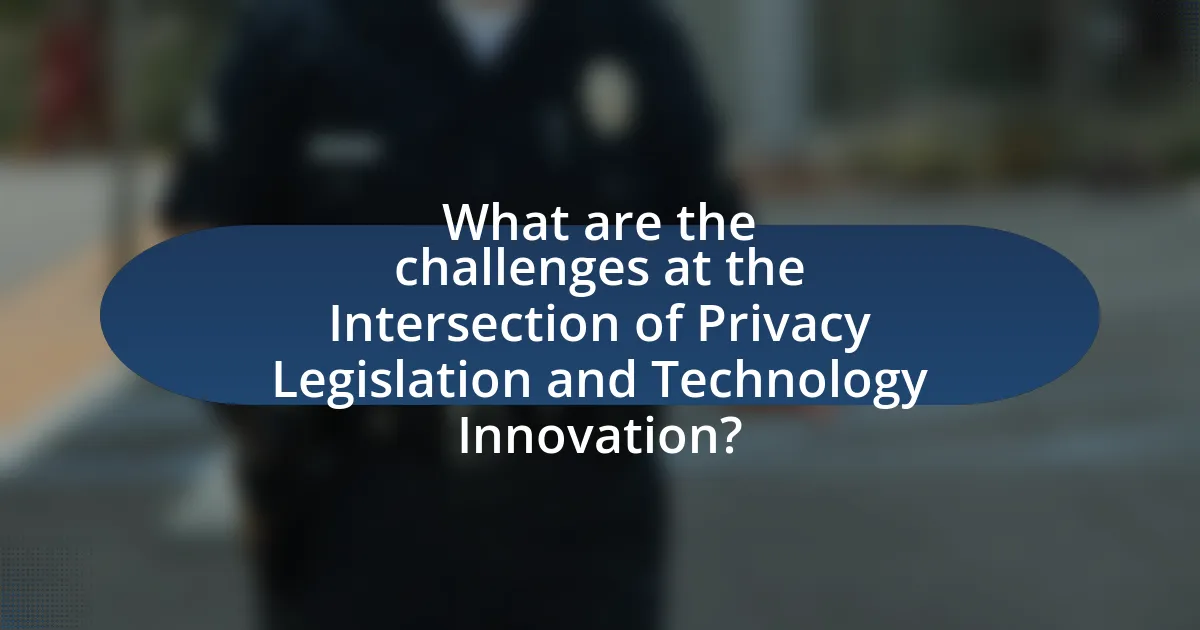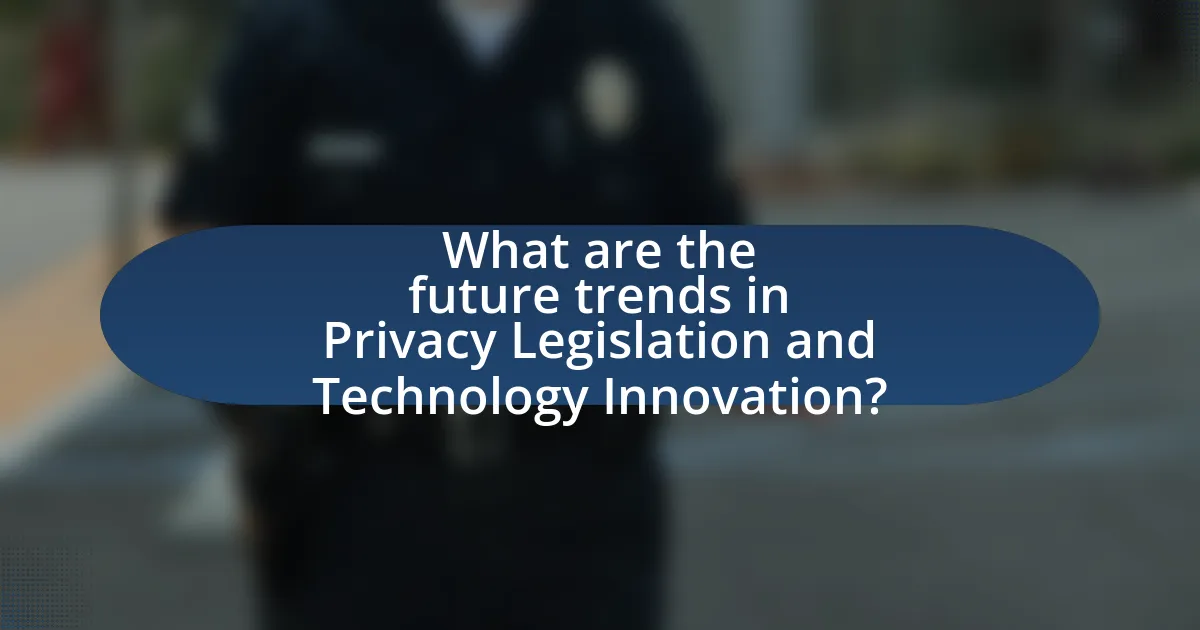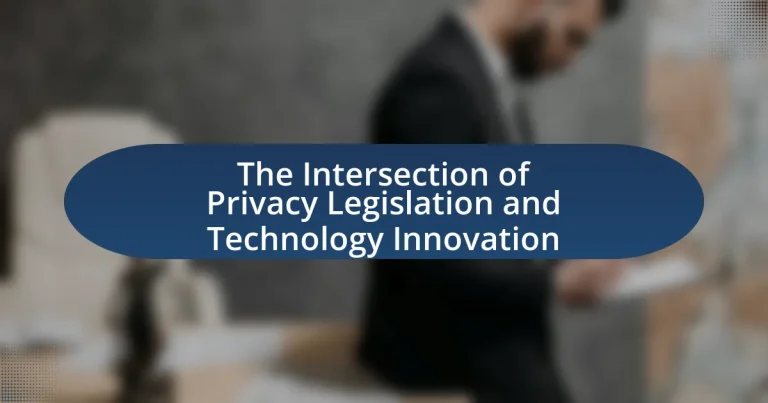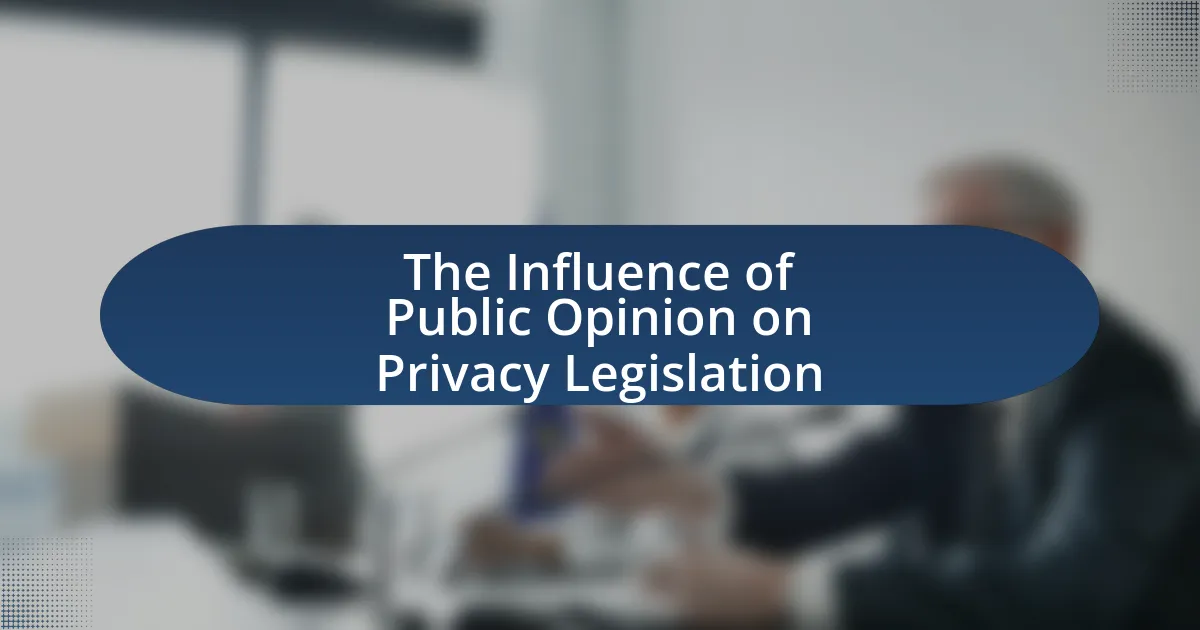The article examines the intersection of privacy legislation and technology innovation, emphasizing the need for regulatory frameworks to adapt to rapid technological advancements while protecting personal data. It discusses key privacy laws such as the General Data Protection Regulation (GDPR) and the California Consumer Privacy Act (CCPA), which influence how companies innovate and manage data. The article highlights the challenges businesses face in complying with varying regulations, the financial implications of non-compliance, and the importance of integrating privacy-by-design principles into technology development. Additionally, it explores future trends in privacy legislation and the role of emerging technologies in enhancing privacy protection.

What is the Intersection of Privacy Legislation and Technology Innovation?
The intersection of privacy legislation and technology innovation is characterized by the need for regulatory frameworks to adapt to rapid technological advancements while ensuring the protection of personal data. As technology evolves, such as through the rise of artificial intelligence and big data analytics, privacy laws like the General Data Protection Regulation (GDPR) in Europe impose strict guidelines on data collection, processing, and storage. These regulations aim to safeguard individual privacy rights, compelling companies to innovate responsibly by integrating privacy-by-design principles into their technologies. For instance, the GDPR mandates that organizations implement data protection measures from the outset of product development, thus influencing how technology is designed and deployed. This dynamic relationship highlights the ongoing challenge of balancing innovation with the necessity of protecting consumer privacy in an increasingly digital world.
How do privacy laws influence technological advancements?
Privacy laws significantly influence technological advancements by establishing regulatory frameworks that dictate how personal data can be collected, used, and shared. These laws compel companies to innovate in ways that prioritize data protection, leading to the development of technologies such as encryption, anonymization, and secure data storage solutions. For instance, the General Data Protection Regulation (GDPR) in the European Union has prompted businesses to adopt privacy-by-design principles, resulting in enhanced user consent mechanisms and improved data security practices. This regulatory environment not only fosters consumer trust but also drives competition among tech companies to create compliant and privacy-centric products, ultimately shaping the direction of technological innovation.
What are the key privacy laws shaping technology today?
The key privacy laws shaping technology today include the General Data Protection Regulation (GDPR), the California Consumer Privacy Act (CCPA), and the Health Insurance Portability and Accountability Act (HIPAA). The GDPR, enacted in 2018, establishes strict guidelines for data protection and privacy for individuals within the European Union, significantly influencing global data practices. The CCPA, effective from 2020, grants California residents enhanced rights regarding their personal information, setting a precedent for state-level privacy laws in the U.S. HIPAA, implemented in 1996, regulates the handling of medical information, ensuring patient privacy in healthcare technology. These laws collectively drive technological innovation by mandating compliance and encouraging the development of privacy-centric solutions.
How do companies adapt to comply with privacy regulations?
Companies adapt to comply with privacy regulations by implementing robust data governance frameworks and enhancing their data protection measures. This includes conducting regular audits to assess compliance with regulations such as the General Data Protection Regulation (GDPR) and the California Consumer Privacy Act (CCPA). For instance, a study by the International Association of Privacy Professionals (IAPP) found that 78% of organizations have updated their privacy policies and practices in response to GDPR. Additionally, companies invest in technology solutions like encryption and access controls to safeguard personal data, ensuring they meet legal requirements and protect consumer trust.
Why is the balance between privacy and innovation important?
The balance between privacy and innovation is important because it ensures that technological advancements do not compromise individual rights and freedoms. When privacy is prioritized, it fosters trust among users, encouraging them to engage with new technologies. For instance, the General Data Protection Regulation (GDPR) implemented in the European Union has set a standard for data protection, compelling companies to innovate responsibly while safeguarding user data. This regulatory framework demonstrates that privacy and innovation can coexist, as businesses that respect privacy often gain a competitive advantage by building customer loyalty and enhancing their brand reputation.
What risks arise from neglecting privacy in technology development?
Neglecting privacy in technology development leads to significant risks, including data breaches, loss of consumer trust, and legal repercussions. Data breaches can expose sensitive personal information, resulting in financial loss and identity theft for individuals. For instance, the 2017 Equifax breach compromised the personal data of approximately 147 million people, highlighting the severe consequences of inadequate privacy measures. Loss of consumer trust can diminish brand reputation and customer loyalty, as seen with Facebook’s Cambridge Analytica scandal, which resulted in a significant decline in user confidence. Additionally, failing to comply with privacy regulations, such as the General Data Protection Regulation (GDPR), can lead to hefty fines; for example, in 2021, Amazon was fined €746 million for GDPR violations. These risks underscore the critical importance of integrating robust privacy practices in technology development.
How can innovation thrive within privacy constraints?
Innovation can thrive within privacy constraints by leveraging privacy-preserving technologies such as differential privacy and federated learning. These technologies enable organizations to analyze and utilize data without compromising individual privacy. For instance, differential privacy allows data scientists to extract insights from datasets while ensuring that the information of any single individual cannot be inferred, thus maintaining compliance with regulations like GDPR. Additionally, federated learning enables machine learning models to be trained across decentralized devices without transferring sensitive data to a central server, thereby enhancing user privacy while still fostering innovation in AI applications. This approach not only aligns with privacy legislation but also encourages the development of new solutions that respect user data rights.

What are the challenges at the Intersection of Privacy Legislation and Technology Innovation?
The challenges at the intersection of privacy legislation and technology innovation include balancing user privacy rights with the rapid pace of technological advancements. Privacy laws often lag behind technological developments, creating gaps that can lead to misuse of personal data. For instance, the General Data Protection Regulation (GDPR) in Europe imposes strict data protection requirements, yet many emerging technologies, such as artificial intelligence and big data analytics, operate in ways that may conflict with these regulations. Additionally, compliance costs for businesses can stifle innovation, as companies may prioritize meeting legal requirements over developing new technologies. Furthermore, differing privacy standards across jurisdictions complicate global operations, making it difficult for companies to navigate varying legal landscapes while trying to innovate.
What obstacles do businesses face in complying with privacy laws?
Businesses face several obstacles in complying with privacy laws, including the complexity of regulations, resource constraints, and the rapid pace of technological change. The complexity arises from the varying requirements across different jurisdictions, such as the General Data Protection Regulation (GDPR) in Europe and the California Consumer Privacy Act (CCPA) in the United States, which can create confusion and compliance challenges. Resource constraints, particularly for small and medium-sized enterprises, limit the ability to implement necessary compliance measures, such as hiring legal experts or investing in compliance technologies. Additionally, the rapid pace of technological innovation often outstrips the development of corresponding privacy regulations, leading to gaps in compliance and increased risk of violations. These factors collectively hinder businesses’ ability to effectively navigate and adhere to privacy laws.
How do varying regulations across regions complicate compliance?
Varying regulations across regions complicate compliance by creating a fragmented legal landscape that organizations must navigate. Different jurisdictions impose unique requirements regarding data protection, consent, and user rights, leading to challenges in standardizing practices. For instance, the General Data Protection Regulation (GDPR) in the European Union mandates strict data handling protocols, while the California Consumer Privacy Act (CCPA) introduces different obligations in the United States. This inconsistency forces companies to invest in diverse compliance strategies tailored to each region, increasing operational complexity and costs.
What are the financial implications of non-compliance?
Non-compliance with privacy legislation can lead to significant financial implications, including hefty fines, legal fees, and loss of business. For instance, the General Data Protection Regulation (GDPR) imposes fines of up to 4% of a company’s global annual revenue or €20 million, whichever is higher, for violations. Additionally, companies may incur costs related to remediation efforts, such as implementing new compliance measures and conducting audits. Non-compliance can also result in reputational damage, leading to decreased customer trust and potential loss of revenue, as studies show that 87% of consumers will not do business with a company that has experienced a data breach.
How does technology outpace privacy legislation?
Technology outpaces privacy legislation primarily due to the rapid pace of innovation and the lag in regulatory frameworks. For instance, advancements in artificial intelligence and data analytics occur at a speed that existing laws, such as the General Data Protection Regulation (GDPR) enacted in 2018, struggle to address comprehensively. The GDPR, while a significant step in privacy protection, does not fully encompass emerging technologies like facial recognition and biometric data collection, which have evolved significantly since its implementation. Additionally, the global nature of technology allows companies to operate across jurisdictions, often exploiting gaps in local privacy laws. This discrepancy creates a scenario where technological capabilities advance faster than the legal mechanisms designed to regulate them, leading to potential privacy violations and challenges in enforcement.
What examples illustrate the gap between tech innovation and privacy laws?
Examples illustrating the gap between tech innovation and privacy laws include the use of facial recognition technology and data collection practices by social media platforms. Facial recognition technology, widely adopted by law enforcement and private companies, often operates without clear legal frameworks governing its use, leading to concerns about surveillance and individual privacy rights. For instance, in 2020, the American Civil Liberties Union reported that cities like San Francisco and Boston had to implement bans on facial recognition due to its potential for misuse and lack of regulatory oversight. Similarly, social media platforms like Facebook have faced scrutiny for their data collection practices, which often exceed user consent and violate privacy expectations. The Cambridge Analytica scandal in 2018 highlighted how user data was harvested without explicit consent, prompting calls for stricter privacy regulations. These examples underscore the ongoing challenges in aligning rapid technological advancements with existing privacy laws.
How can lawmakers keep up with rapid technological changes?
Lawmakers can keep up with rapid technological changes by actively engaging with technology experts and stakeholders to understand emerging trends. This engagement can include forming advisory committees that consist of technologists, ethicists, and industry leaders who can provide insights into the implications of new technologies. For instance, the European Union has established the Digital Services Act, which was informed by extensive consultations with tech companies and civil society, demonstrating a proactive approach to legislation that adapts to technological advancements. Additionally, lawmakers can implement flexible regulatory frameworks that allow for adjustments as technology evolves, ensuring that legislation remains relevant and effective in addressing privacy concerns and innovation.

What are the future trends in Privacy Legislation and Technology Innovation?
Future trends in privacy legislation and technology innovation include the increasing adoption of comprehensive data protection laws, such as the General Data Protection Regulation (GDPR) and the California Consumer Privacy Act (CCPA), which are influencing global standards. These laws are driving organizations to implement advanced privacy technologies, such as artificial intelligence for data anonymization and blockchain for secure data transactions. Additionally, there is a growing emphasis on user consent and transparency, as seen in the rise of privacy-by-design frameworks that integrate privacy considerations into the development of new technologies. The trend towards regulatory harmonization across jurisdictions is also notable, as countries seek to align their privacy laws to facilitate international business while protecting consumer rights.
How is technology shaping the future of privacy legislation?
Technology is significantly shaping the future of privacy legislation by driving the need for more robust data protection laws. The rapid advancement of digital technologies, such as artificial intelligence and big data analytics, has increased the volume and sensitivity of personal data collected by organizations. This has prompted lawmakers to respond with regulations like the General Data Protection Regulation (GDPR) in Europe, which sets stringent requirements for data handling and user consent. Additionally, emerging technologies like blockchain are influencing legislative frameworks by offering new methods for secure data storage and user control, thereby necessitating updates to existing laws to accommodate these innovations. As a result, technology not only challenges current privacy norms but also catalyzes the development of comprehensive legal frameworks that aim to protect individual privacy rights in an increasingly digital world.
What role do emerging technologies play in privacy protection?
Emerging technologies play a crucial role in enhancing privacy protection by providing advanced tools and methodologies for data security and user anonymity. Technologies such as encryption, blockchain, and artificial intelligence enable organizations to safeguard personal information against unauthorized access and breaches. For instance, encryption algorithms protect data in transit and at rest, making it unreadable to unauthorized users. Blockchain technology offers decentralized data storage, which enhances transparency and reduces the risk of data tampering. Additionally, artificial intelligence can identify and mitigate privacy risks by analyzing patterns in data usage and flagging potential vulnerabilities. These technologies collectively contribute to a more robust privacy framework, aligning with evolving privacy legislation aimed at protecting individual rights.
How might AI influence privacy laws in the coming years?
AI is likely to significantly influence privacy laws in the coming years by necessitating more stringent regulations to address data collection and usage practices. As AI technologies evolve, they increasingly rely on vast amounts of personal data, raising concerns about user consent and data security. For instance, the General Data Protection Regulation (GDPR) in Europe has already set a precedent by emphasizing the importance of data protection and user rights, which may lead to similar frameworks being adopted globally. Furthermore, as AI systems become more autonomous, lawmakers may need to establish clearer guidelines on accountability and liability for data breaches or misuse, prompting a reevaluation of existing privacy laws.
What best practices can organizations adopt for compliance?
Organizations can adopt several best practices for compliance, including implementing robust data governance frameworks, conducting regular risk assessments, and ensuring employee training on compliance policies. A strong data governance framework establishes clear policies for data management, which is essential for adhering to privacy legislation. Regular risk assessments help identify vulnerabilities and ensure that compliance measures are effective. Furthermore, training employees on compliance policies fosters a culture of accountability and awareness, reducing the likelihood of violations. According to a 2021 survey by the International Association of Privacy Professionals, organizations with comprehensive training programs reported 30% fewer compliance incidents compared to those without such initiatives.
How can companies integrate privacy by design into their innovations?
Companies can integrate privacy by design into their innovations by embedding privacy considerations into the entire lifecycle of product development. This involves conducting privacy impact assessments during the design phase, ensuring data minimization principles are applied, and implementing strong data protection measures from the outset. For instance, the General Data Protection Regulation (GDPR) mandates that organizations incorporate privacy by design, which has led many companies to adopt practices such as pseudonymization and encryption to protect user data. By proactively addressing privacy concerns, companies not only comply with legal requirements but also build trust with consumers, as evidenced by studies showing that 79% of consumers are more likely to engage with brands that prioritize data privacy.
What tools are available to help businesses navigate privacy regulations?
Businesses can utilize various tools to navigate privacy regulations, including compliance management software, data mapping tools, and privacy impact assessment (PIA) tools. Compliance management software, such as OneTrust and TrustArc, helps organizations manage their compliance with regulations like GDPR and CCPA by providing frameworks for tracking and reporting compliance activities. Data mapping tools, like BigID, assist businesses in identifying and classifying personal data across their systems, which is essential for understanding data flows and ensuring compliance. Privacy impact assessment tools, such as Nymity, enable organizations to evaluate the risks associated with data processing activities and implement necessary safeguards. These tools collectively support businesses in adhering to privacy regulations effectively and efficiently.





